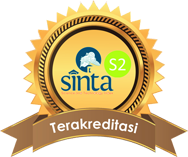DEVELOPMENT OF STEM (SCIENCE, TECHNOLOGY, ENGINEERING, AND MATHEMATIC) INTEGRATED CHEMICAL MODULE ON VOLTAIC CELLS
DOI:
https://doi.org/10.15575/jtk.v5i1.8127Keywords:
development research, chemical modules, STEM, project based learning, voltaic cellsAbstract
21st century requires generation to have high competitiveness and competence in various aspect. Moreover,challenges in the teaching and learning process on chemical subjects, such as voltaic cells, which has abstract and contextual characteristics, as a problem to be solved. This study aimed to produce an integrated chemical module STEM Project Based Learning on the topic of valid and practical voltaic cells. The development of STEM integrated chemical module on the topic of the Voltaic cell used ADDIE model namely Analyze, Design, Development, Implementation and Evaluation. Data was collected through needs analysis, expert testing and student questionnaire responses. At the expert review stage, using 7 material experts and 7 media experts. The implementation phase was carried out in one of the high schools in Serang City. The result of the expert test stage obtained a final score of material validation of 88.25% (very feasible or very valid) and media validation of 82% (very feasible or very valid) with an average score of validity of 87% (very feasible or very valid). For the final score of feasibility obtained from 81% limited trials (very feasible). The characteristics of the developed module was STEM module which follows the Laboy-Rush PjBL-STEM syntax namely refelection, research, discovery, application, and communication. It was made by A5 paper size to make it easy to carry and prepared by various illustrations, interesting features and STEM-Project and design log to complete Voltaic cell project. Furthermore, it is hoped that this module can be used as an alternative STEM teaching material on voltaic cell topic.
References
Anggoro, B. S. (2015). Pengembangan Modul Matematika Dengan Strategi Problem Solvin Guntuk Mengukur Tingkat Kemampuan Berpikir Kreatif Matematis Siswa. Jurnal Pendidikan Matematika, 6(2).
Arumsari, N. (2014). Pengembangan Modul Barbasisproject Basedlearning Untuk Mengoptimalkan Kemandirian Dan Hasil Belajar Fisika Pada Siswa Kelas X Sma Negeri 1 Kutowinangun Tahun Pelajaran 2013/2014.
Astiti, N. L. (2014). Pengembangan Modul Pembelajaran Matematika di SMP Negeri I Banjar untuk Siswa Kelas VII Semester Genap. Retrieved November 20, 2019, from e-Jurnal Undiksa website
Butts, B., & Smith, R. (1987). What do students perceive as difficult in H.S.C. chemistry? Australian Science Teachers’ Journal, 32(4), 4551.
Capraro, R. M., & Scott, W. S. (2009). Project-Based Learning An Integrated Science, Technology, Engineering, Math (STEM) Approach. Rotterdam: Sense Publisher.
Daryanto. (2014). Pendekatan Pembelajaran Saintifik Kurikulum 2013. Yogyakarta: Gavamedia.
Ismayani, A. (2016). Pengaruh Penerapan STEM Project - Based Learning terhadap Kreativitas Matematis Siswa SMK. Indonesian Digital Journal of Mathematics and Education, 3, 264–272.
Jauhariyyah, F. R., Suwono, H., & Ibrohim. (2017). Science , Technology , Engineering and Mathematics Project Based Learning ( STEM-PjBL ) pada Pembelajaran Sains. 2, 432–436.
Juanggo, W. (2018). Model Pembelajaran Berbasis STEM dan Revolusi Industri 4.0.
Laboy-Rush, D. (2010). Integrated STEM education through project-based learning. Retrieved from (www.learning.com/stem/whitepaper/integrated-STEM-throughProject-basedLearning
Lamanauskas, V., Vilkonien, M., & Vilkonis, R. (2007). The Chemistry Component of Natural Science Education in Primary and Basic School: Some Major Issues. Bulgarian Journal of Science and Education Policy (BJSEP), 1, 57–75.
Lasmiyati, L., & Harta, I. (2014). Pengembangan Modul Pembelajaran untuk Meningkatkan Pemahaman Konsep dan Minat SMP. Jurnal Matematika Pendidikan Matematika UNY, 9(2
Lin, H. U.-S., Yang, T. C., Chiu, H. O.-L. D. I., & Chou, D. A. N. C. H.-Y. A. N. G. (2003). Kesulitan siswa dalam Pembelajaran Elektrokimia. 12(3), 100–105.
M. Adlim, Saminan, & Ariestia, S. (2015). Pengembangan Modul STEM Terintegrasi Kewirausahaan Untuk Meningkatkan Keterampilan Proses Sains Di Sma Negeri 4 Banda Aceh. 03(02).
M, S. R., Adlim, & Mursal. (2015). Pengembangan Lks STEM (Science, Technology, Engineering, And Mathematics) Dalam Meningkatkan Motivasi Dan Aktivitas Belajar Siswa Sma Negeri 1 Beutong Pada Materi Induksi Elektromagnetik. 03(01), 239–250.
Moslem, M. C., Komaro, M., & Indonesia, U. P. (2019). Faktor-Faktor yang Menyebabkan Rendahnya Motivasi Belajar Siswa dalam Mata Pelajaran Aircraft Drawing di SMK.
Noeraida, & Sulaeman, A. A. (2018). Mata Pelajaran IPA SMP Pembangkit Listrik Tenaga Minihidro ( PLTMH ).
NSTA. (2014). STEM START HERE. Retrieved from NGSS@NSTA website: https://ngss.nsta.org/PracticesFull.aspx
Research, H. (2011). K-12 STEM Education Overview. Retrieved from https://www.yumpu.com/en/document/read/7763878/k-12-stem-education-overview-hanover-research
Sulcius, A. (2016). Student Misconceptions In Studing “ Galvanic Cells †Student Misconceptions In Studing “ Galvanic Cells .†(March 2014).
Tegeh, I. M., & Kirna, I. M. (2014). Pengembangan Bahan Ajar Metode Penelitian Pendidikan Dengan ADDIE Model. 2, 12–26.
Tjiptiany, E. N., Muksar, M., Matematika, P., & Malang, P. N. (2016). Pengembangan Modul Pembelajaran Untuk Membantu Siswa Sma Kelas X Dalam Memahami Materi Peluang. (2009), 1938–1942.
Utami, T. N., & Jatmiko, A. (2018). Pengembangan Modul Matematika dengan Pendekatan Science, Technology, Engineering, And Mathematics (STEM) pada Materi Segiempat. 1(2), 165–172.
Wells, J. (2016). PIRPOSAL Model of Integrative STEM Education: Conceptual and Pedagogical Framework for Classroom Implementation. Technology and Engineering Teacher, 75(6), 12–19.
Downloads
Published
How to Cite
Issue
Section
Citation Check
License
Authors who publish with this journal agree to the following terms:
- Authors retain copyright and grant the journal right of first publication with the work simultaneously licensed under a Creative Commons Attribution-ShareAlike that allows others to share the work with an acknowledgement of the work's authorship and initial publication in this journal.
- Authors are able to enter into separate, additional contractual arrangements for the non-exclusive distribution of the journal's published version of the work (e.g., post it to an institutional repository or publish it in a book), with an acknowledgement of its initial publication in this journal.
- Authors are permitted and encouraged to post their work online (e.g., in institutional repositories or on their website) prior to and during the submission process, as it can lead to productive exchanges, as well as earlier and greater citation of published work (See The Effect of Open Access).








